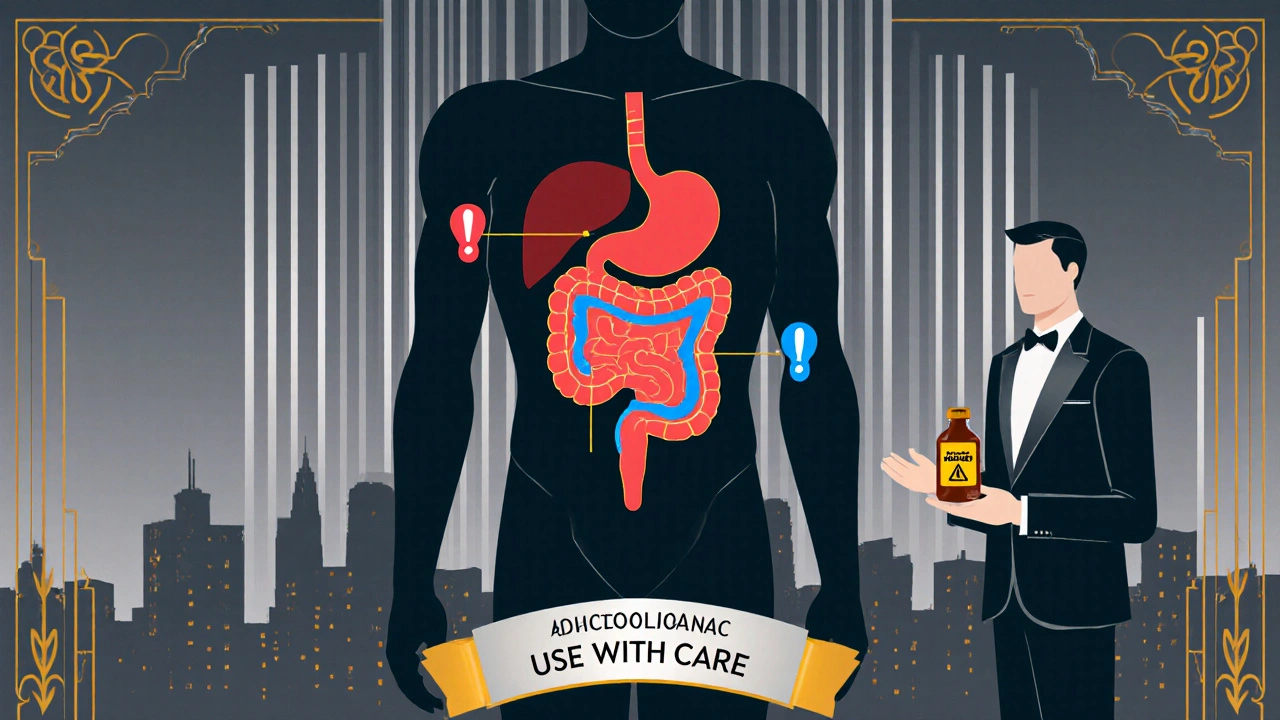Diclofenac Sodium Dosage Calculator
Personalized Dosage Guidance
Based on your arthritis type, pain level, and health factors, this tool recommends appropriate diclofenac sodium dosing while highlighting safety considerations.
Recommended Dosage
Living with arthritis means dealing with joint pain, stiffness, and swelling on a daily basis. You’ve probably tried a few over‑the‑counter options, but the name diclofenac sodium keeps popping up in pharmacy aisles and doctor’s notes. What makes this drug a go‑to for many arthritis sufferers, and what should you watch out for? Below is a plain‑spoken guide that walks you through everything you need to know before you reach for the bottle.
What is Diclofenac Sodium?
Diclofenac Sodium is a non‑steroidal anti‑inflammatory drug (NSAID) that works by blocking the enzyme cyclo‑oxygenase (COX). By inhibiting COX‑1 and COX‑2, it reduces the production of prostaglandins - the chemicals that cause pain, fever, and inflammation. The compound was first approved in Europe in the early 1970s and has become a staple for treating musculoskeletal pain.
How Does It Help Arthritis?
Arthritis isn’t a single disease; it covers a range of conditions that affect joints. The two most common forms are Osteoarthritis - a wear‑and‑tear degeneration of cartilage - and Rheumatoid arthritis, an autoimmune attack on joint linings. In both cases, inflammation drives pain and stiffness. Diclofenac’s COX inhibition cuts down that inflammation, which translates into softer joints and fewer flare‑ups. Clinical trials have shown that patients taking diclofenac report a 30‑40% reduction in pain scores compared with placebo.
Dosage Forms and Typical Regimens
Diclofenac comes in several flavors:
- Oral tablets (usually 25mg, 50mg, or 75mg)
- Extended‑release tablets (often 100mg)
- Topical gel or cream (1% or 3% concentration)
For moderate to severe arthritis pain, doctors commonly start patients on 50mg taken twice daily. If the pain is milder, a once‑daily 75mg extended‑release tablet might suffice. The topical gel is a good alternative for people who can’t tolerate oral NSAIDs; you apply a thin layer to the affected joint 3-4 times a day. Always follow the prescribing doctor’s instructions - taking more than the recommended dose doesn’t speed relief but raises the risk of side effects.
Benefits and Effectiveness
When used correctly, diclofenac delivers fast pain relief, often within an hour, and lasting anti‑inflammatory effects for up to 12hours. Studies comparing it with other NSAIDs have found it slightly more effective at reducing swelling in knee osteoarthritis. The drug also has a relatively short half‑life (about 1.5hours), which means it clears the system fairly quickly once you stop taking it.

Potential Risks and Side Effects
Like any NSAID, diclofenac isn’t without downsides. The most common complaints are stomach upset, nausea, and mild headache. More serious risks, however, deserve close attention:
- Gastrointestinal bleeding - ulcers or bleeding can occur, especially if you take the drug on an empty stomach or combine it with alcohol.
- Cardiovascular risk - long‑term use has been linked to higher chances of heart attack or stroke, particularly in people with existing heart disease.
- Kidney damage - NSAIDs can reduce blood flow to the kidneys, leading to impaired function over time.
- Liver enzyme elevation - rare but possible, usually reversible after stopping the medication.
If you notice black tarry stools, sudden swelling of the legs, or severe chest pain, stop the drug and seek medical help right away.
Who Should Avoid Diclofenac?
While diclofenac helps many, it’s contraindicated for certain groups:
- People with a history of peptic ulcers or gastrointestinal bleeding.
- Those with uncontrolled high blood pressure, heart failure, or a recent heart attack.
- Pregnant women in their third trimester - the drug can affect fetal circulation.
- Children under 12 years old (the oral form is not approved for them).
- Anyone on anticoagulants such as warfarin without close monitoring.
Drug Interactions to Watch
Diclofenac can play badly with a handful of other medicines. Here are the most common culprits:
- Warfarin - increased bleeding risk.
- ACE inhibitors or ARBs (e.g., lisinopril) - may reduce kidney protection.
- Other NSAIDs or aspirin - additive GI toxicity.
- Selective serotonin reuptake inhibitors (SSRIs) - higher chance of stomach bleeding.
- Alcohol - amplifies liver and GI side effects.
Always give your pharmacist a complete medication list, including over‑the‑counter supplements like fish oil or herbal extracts.

Diclofenac vs. Other NSAIDs
| Drug | Typical Dose for Arthritis | Half‑Life | COX Selectivity | Common Side Effects |
|---|---|---|---|---|
| Diclofenac Sodium | 50mg twice daily | 1.5h | Non‑selective (COX‑1 & COX‑2) | GI upset, cardiovascular risk |
| Ibuprofen | 400‑800mg three times daily | 2h | Non‑selective | Stomach irritation, kidney strain |
| Naproxen | 250‑500mg twice daily | 12‑15h | COX‑1 > COX‑2 | Long‑term GI bleeding, edema |
| Celecoxib | 200mg once daily | 11h | COX‑2 selective | Less GI upset, still cardiovascular concern |
Choosing the right NSAID depends on your personal risk profile. If you have a history of stomach ulcers, a COX‑2 selective option like celecoxib may be safer, but it still carries heart‑related warnings.
Tips for Safe Use
- Take the tablet with food or a full glass of milk to cushion the stomach lining.
- Limit alcohol consumption - even a single drink can tip the balance toward bleeding.
- Track blood pressure and weight; sudden rises may signal fluid retention.
- Schedule regular blood tests if you’re on diclofenac for more than a few weeks - liver enzymes and kidney function should be checked.
- Never combine oral diclofenac with another NSAID unless a doctor explicitly says it’s okay.
Alternatives and Complementary Approaches
If you’re worried about the side‑effect profile, you have options:
- Other NSAIDs - ibuprofen or naproxen may be gentler for some people.
- Topical formulations - a 1% diclofenac gel offers localized relief with less systemic exposure.
- Physical therapy - targeted exercises improve joint mobility and reduce dependence on medication.
- Supplements such as glucosamine, chondroitin, or omega‑3 fatty acids - evidence is mixed but some patients notice reduced stiffness.
- Intra‑articular steroid injections - provide short‑term flare control when oral meds aren’t enough.
Discuss these alternatives with your rheumatologist or primary care provider to craft a plan that balances pain control with safety.
Frequently Asked Questions
Can I take diclofenac daily for years?
Long‑term daily use is possible but requires regular monitoring of kidney, liver, and cardiovascular health. Most doctors limit continuous therapy to 2-3 months before reassessing.
Is the topical gel as effective as oral tablets?
For mild‑to‑moderate knee or hand arthritis, the gel can provide comparable pain relief with fewer systemic side effects. It’s less effective for severe, deep joint pain.
What should I do if I miss a dose?
Take the missed tablet as soon as you remember, unless it’s almost time for the next dose. In that case, skip the missed one - don’t double‑dose.
Can diclofenac be taken with antihypertensive medication?
Yes, but NSAIDs can blunt the blood‑pressure‑lowering effect of some drugs. Your doctor may need to adjust the antihypertensive dose.
Is diclofenac safe for people with asthma?
Asthma patients can be more prone to NSAID‑induced bronchospasm. If you have a history of aspirin‑sensitive asthma, avoid diclofenac unless a specialist says it’s okay.
Arthritis pain doesn’t have to control your life, but choosing the right medication matters. By understanding how diclofenac sodium works, its proper dosing, and the potential hazards, you can have a candid conversation with your healthcare provider and make an informed decision.


Rebecca Mitchell
October 17, 2025 AT 15:10Not every NSAID is the same, read the label.
Roberta Makaravage
October 18, 2025 AT 18:06Diclofenac is a double‑edged sword, and you need to wield it with wisdom 😊. The drug’s COX inhibition can bring swift relief, but that same mechanism meddles with the protective prostaglandins in your stomach lining. If you swallow a tablet on an empty stomach, you’re practically inviting ulceration to the party. Moreover, the cardiovascular warnings aren’t just footnotes; they’re serious alerts that merit a conversation with your cardiologist. Long‑term users should have their blood pressure checked regularly because NSAIDs can blunt the effect of antihypertensives. Kidney function isn’t immune either – occasional labs can catch early signs of nephrotoxicity before it becomes irreversible. On the bright side, the topical gel offers a localized approach that sidesteps much of the systemic exposure, making it a smart option for mild‑to‑moderate joint pain. Remember to apply a thin layer and wash your hands afterward to avoid accidental transfer to eyes. If you’re on anticoagulants like warfarin, the bleeding risk skyrockets, so coordinated care is a must. Lifestyle factors matter: limit alcohol, stay hydrated, and maintain a balanced diet rich in fiber to protect your gut. The half‑life of diclofenac is fairly short, so the drug clears quickly once you discontinue, but the damage done during use can linger. For people with a history of heart disease, a COX‑2 selective alternative like celecoxib may present a reduced cardiovascular profile, though it isn’t free from risk. In the end, the decision hinges on a personal risk‑benefit analysis – weigh the pain relief against the potential side‑effects. Communicate openly with your healthcare team and never self‑adjust the dose. Knowledge empowers you to use this medication responsibly 😊.
Patricia Echegaray
October 19, 2025 AT 23:16Let’s not forget that the pharma giants have a vested interest in keeping us hooked on drugs like diclofenac. They flood the market with glossy brochures while subtly downplaying the long‑term vascular fallout. The “clinical trials” you read about are often funded by the very companies that stand to profit from any adverse event being swept under the rug. If you dig deeper, you’ll see a pattern: a surge in cardiovascular incidents coinciding with the rise of NSAID prescriptions. It’s not a coincidence, it’s a calculated move to monetize our chronic pain. Moreover, the regulation agencies are riddled with revolving‑door personnel who once worked for these manufacturers. That’s why the label warnings are often vague, leaving patients unaware of the silent dangers. And let’s be crystal‑clear: the “topical gel” is marketed as a harmless alternative, yet the same active ingredient still seeps systemically, especially with repeated applications. Stay vigilant, question the narrative, and demand transparency from both your doctor and the drug companies.
Malia Rivera
October 21, 2025 AT 01:40When we contemplate the ethical dimension of pain relief, we stumble upon a paradox: alleviating suffering versus courting potential harm. Diclofenac exemplifies this dilemma, offering swift solace while courting the specter of gastric bleeding. One might argue that the pursuit of comfort justifies measured risk, yet the principle of non‑maleficence whispers caution. It’s a delicate balance, and each individual must weigh the transient gain against the lasting imprint on organ systems. In the grand tapestry of health, perhaps the most prudent path lies in integrating modest pharmacotherapy with movement, nutrition, and mindful practices. The drug, then, becomes a tool rather than a crutch, a measured brushstroke on the canvas of recovery.
Sara Werb
October 22, 2025 AT 06:50OMG!!! I can’t even with how people think a cream will just "magically" fix everything!!! It's like, you slather it on, hope for the best, and then I’m like, "where's the side‑effects?" You gotta READ the fine print!!! The pharma machine is pulling the strings!!! And don’t get me started on those "studies" they quote – cherry‑picked!!! Trust no one!!
Russell Abelido
October 23, 2025 AT 09:13Hey folks, I totally get the anxiety around NSAIDs. I’ve seen friends struggle with stomach upset, and it’s scary. The good news is that you can mitigate some risks by taking the pill with a hearty meal or a glass of milk, and keeping an eye on any unusual symptoms. If you experience any swelling or chest pain, it’s crucial to seek help right away. Also, regular check‑ups with your doctor can catch early signs of kidney or liver strain. Remember, you’re not alone in navigating this – sharing experiences helps us all make smarter choices. Stay safe! 😊
Steve Holmes
October 24, 2025 AT 13:00Sure thing – adding a NSAID like diclofenac to a regimen that already includes a ACE inhibitor can be a bit of a tightrope. The kidneys love that combo, so monitoring creatinine levels every few weeks is a smart move. Also, make sure the timing of doses doesn’t overlap with your blood‑pressure meds to avoid any surprise dips in effectiveness. Staying on top of lab work and keeping an open line with your prescriber will keep everything running smoothly.
Tom Green
October 25, 2025 AT 16:46When you’re considering diclofenac, think of it as a teammate in your health plan, not the star player. Start with the lowest effective dose and pair it with lifestyle tweaks – like low‑impact exercise, a balanced diet, and adequate hydration. Schedule routine blood work to keep an eye on liver and kidney markers. If you notice any red flags, contact your clinician promptly. This collaborative approach helps you reap the pain‑relief benefits while safeguarding long‑term wellness.
Emily Rankin
October 26, 2025 AT 20:33Let’s look on the bright side – the fact that we have options like diclofenac means we’re not powerless against arthritis pain. By using the medication responsibly and pairing it with physical therapy, you can reclaim a lot of mobility. Imagine enjoying a morning walk without that nagging stiffness! Keep the conversation open with your doctor, stay vigilant about side‑effects, and celebrate each small victory on your journey to comfort.